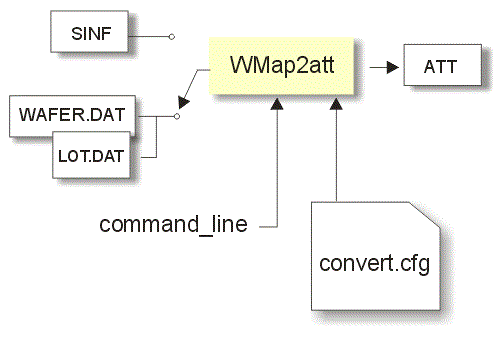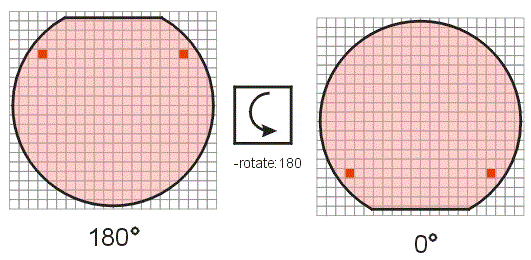

Some of our customers would like to use WMapConvert as part of a script that can convert a large number of wafer maps to a different format without any user intervention.
While WMapConvert was not originally programmed with this feature in mind, we have embarked on a project to make a command line version. This is a fairly large project given the large number of input/output map file formats as well as a large number of rules that define the correct syntax of the various formats.
So we will be adding formats as our customers place orders for their particular situation.

Flow for using WMap2ATT converter.
wmap2att.exe input_file file_type output_file -cfg:file.cfg [options]whereinput_file full path to the input map filefile_type either SINF or TELP8output_file full path to the output file-cfg:file.cfg full path to the configuration file[options]-lot:filename full path to lot file name (only when TELP8 is specified) default is to look for LOT.DAT in same directory as the WAFER.DAT file-rotate:degrees [0|90|180|270]-silent no messages to screen-log:log_file full path to log file nameAt present, the configuration file contains only bin code mappings. However we expect that as more formats and directives are supported we will expand the the ability of the user to put additional controls in the configuration file.
Comments - if you wish to add comment lines to the configuration file, use the # symbol in column 1. The # symbol cannot be used in other columns since it is a valid bin code in the ATT format.
Each line has at a minimum, an input bin code and an output bin code which are separated by a comma. Bin codes may have different lengths but they may not contain spaced in them.
Examples of valid bin codes:
1
01
001
A1
C
.
__
#
Examples of invalid bin codes:
, used as delimiter
0 1 space not allowed
A 1 space not allowed
# SINF to ATT Bin Mapping___,.002,P003,F004,F000,F037,$Sometimes to produce data in a format required by the next machine, it is necessary to rotate the data so that the wafer flat is in certain position. For example, if your input file has the wafer flat at the TOP, and your machine operates with the assumption that the data is presented with the wafer flat at the bottom, then a 180 degree rotation will produce the desired output.

In this case use the command line option -rotate:180 which will provide the correct amount of rotation.
| SINF | ATT |
|---|---|
| DEVICE:AFSW-B3895_CUP | NO EQUIVALENT FIELD |
| LOT:M50738.1 | M50738.1 |
| WAFER:M50738-01C7 | M50738-01C7 |
| FNLOC:180 | B BOTTOM |
| ROWCT:72 | 072 |
| COLCT:128 | 128 |
| BCEQU:000 | NOT CURRENTLY READ |
| REFPX:10 | 010 |
| REFPY:44 | 044 |
| DUTMS:mm | NO EQUIVALENT FIELD |
| XDIES:1.4919 | 01492 |
| YDIES:2.632 | 02632 |
If no configuration file is used then the default behavior is to map all bin codes to FAIL (i.e. #)
Therefore we recommend that the user always use a configuration file, and at the minimum, map the PASS bin codes and the NULL bin code. It is not necessary to map the FAIL bin codes since if an unmapped bin code is encountered, it will be mapped as a FAIL. If a separate bin code is used for reference devices these too should be mapped. An example file, panther1.cfg is shown below:
# Bin mapping for SINF 2 ATT (panther)
# NULL die mapping
___,.
# pass bin code
000,P
# Reference die bin code
037,$
# Fail. If not mapped, these will be FAIL by default.
002,#
001,#
003,#
004,#
093,#
092,#
091,#
021,#
031,#
The purpose of the ATTMerge program is to merge two incoming ATT files and to produce a third ATT file which is generated by applying the truth table.
Conditions for Merging
Before any merging will be performed the two ATT files are checked to verify that:The Merging Rules
For each die position the following rules are applied to produce a new output at that position. These rules are hard-wired and cannot be changed by the user.
Command Line